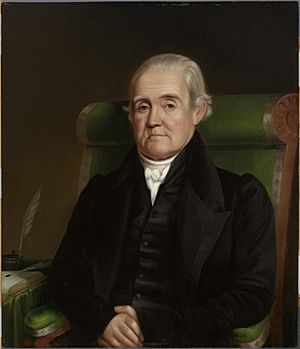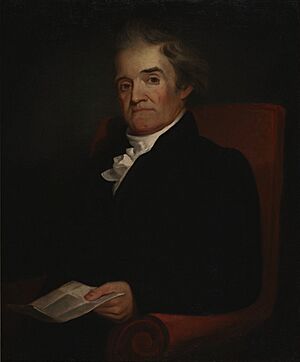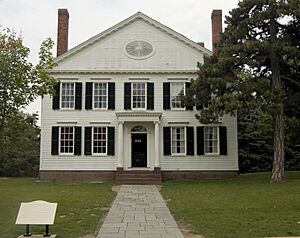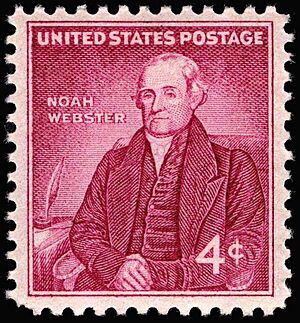Noah Webster facts for kids
Quick facts for kids
Noah Webster
|
|
|---|---|

Portrait by James Herring, 1833
|
|
| Member of the Connecticut House of Representatives | |
| In office 1800; 1802 – 1807 |
|
| Personal details | |
| Born |
Noah Webster Jr.
October 16, 1758 Western Reserve of Hartford, Connecticut Colony, British North America |
| Died | May 28, 1843 (aged 84) New Haven, Connecticut, U.S. |
| Resting place | Grove Street Cemetery |
| Political party | Federalist |
| Spouse |
Rebecca Greenleaf Webster
(m. 1789) |
| Children | 8 |
| Residences |
|
| Alma mater | Yale College |
| Occupation |
|
| Military service | |
| Allegiance | United States |
| Branch/service | Connecticut Militia |
| Battles/wars | American Revolutionary War |


Noah Webster Jr. (born October 16, 1758 – died May 28, 1843) was an important American writer and educator. He is often called the "Father of American Scholarship and Education." He created famous books that taught American children how to spell and read. His name is now closely linked with "dictionary" in the United States. The well-known Merriam-Webster dictionary comes from his original work, An American Dictionary of the English Language, first published in 1828.
Contents
Who Was Noah Webster?
Noah Webster was a lexicographer (someone who writes dictionaries), a pioneer in creating textbooks, and a reformer of English spelling. He also wrote about politics and worked as an editor.
Early Life and Education
Noah Webster was born in West Hartford, Connecticut. His family was well-known in the area. His father was a farmer, a church leader, and a militia captain. His mother taught him spelling, math, and music.
At age six, Noah went to a small, old one-room school. He felt the teachers and lessons were not very good. This experience made him want to make education better for future students.
When he was 14, his pastor helped him prepare for Yale College. He started at Yale just before his 16th birthday in 1774. His time at Yale happened during the American Revolutionary War. Because of the war, some classes had to be held in other towns. Noah also served in the Connecticut Militia.
After graduating from Yale in 1779, Webster struggled to find a career. He taught school for a short time, but the pay was low. He then studied law and passed the bar exam in 1781. However, the Revolutionary War made it hard to find work as a lawyer. He opened a small private school, which was successful for a while.
A Supporter of the New Nation
Webster strongly supported the American Revolution and the new Constitution of the United States. He believed America needed its own strong intellectual foundation, separate from Europe. He thought American values were better.
In 1793, Alexander Hamilton asked Webster to move to New York City. There, Webster became an editor for a Federalist Party newspaper. He wrote many articles, essays, and textbooks. He defended Presidents George Washington and John Adams. He also criticized the French Revolution and its violence.
Webster moved back to New Haven, Connecticut, in 1798. He served in the Connecticut House of Representatives from 1800 to 1807. He also helped start Amherst College in Massachusetts in 1812.
Family Life
Noah Webster married Rebecca Greenleaf in 1789. They had eight children together. Even though he married into an important family, he didn't have a lot of money.
The "Blue-Backed Speller"
As a teacher, Webster saw many problems in American elementary schools. Schools were often crowded, with many children of different ages in one room. Teachers were underpaid, and textbooks came from England. Webster believed Americans should learn from American books.
Why He Wrote It
He started writing a three-part series called A Grammatical Institute of the English Language. This included a speller (published in 1783), a grammar book (1784), and a reader (1785). His goal was to create a unique American way to teach children. He wanted to make English grammar and pronunciation easier to understand. He felt that the English language had been "corrupted" by the British upper class. Webster believed that the American people should control their language, just like they controlled their government.
How It Taught Kids
The Speller was designed to be easy to teach and followed a logical order. Webster believed that students learned best when complex problems were broken into smaller parts. He thought children learned in different stages. For example, he said a three-year-old couldn't read, but a five-year-old could.
His speller started with the alphabet. Then it moved to vowel and consonant sounds, then syllables, then simple words, and finally more complex words and sentences.
The Speller was first called The First Part of the Grammatical Institute of the English Language. Later, its name changed to The American Spelling Book and then The Elementary Spelling Book. Most people called it the "Blue-Backed Speller" because of its blue cover. For over 100 years, this book taught millions of American children how to read, spell, and say words. It was the most popular American book of its time. The small royalty (half a cent per copy) helped Webster fund his other projects. It also helped create spelling bee contests.
Spelling Changes
Over time, Webster changed the spellings in his book to be more phonetic (matching how words sound). Many of these spellings were already alternative options. He chose spellings like defense, color, and traveler. He also changed re to er in words like center. He tried to change tongue to tung, but that change didn't become popular.
The third part of his Grammatical Institute (1785) was a reader. It aimed to teach children about virtue and patriotism. It included writings from famous authors and American figures. It also had an essay calling for the end of slavery, based on the ideas in the Declaration of Independence.
Webster's early Speller was secular, meaning it didn't focus on religion. It ended with important dates in American history. Later in life, Webster became very religious and added religious themes to his books.
Creating the American Dictionary
In 1806, Webster published his first dictionary, A Compendious Dictionary of the English Language.
A Huge Undertaking
The next year, in 1807, Webster started working on a much larger and more complete dictionary. This project took him 26 years to finish! To understand where words came from (their etymology), Webster learned 28 different languages. These included Old English, Greek, Latin, Hebrew, and Arabic.
Webster wanted to standardize American English. People in different parts of the country used, spelled, and pronounced words differently.
He finished his dictionary in January 1825 while living in England. The book had 70,000 words. About 12,000 of these words had never been in a published dictionary before.
What Made It Special
As a spelling reformer, Webster preferred spellings that matched how words were pronounced. He helped popularize spellings like center, color, and check in America. He also added American words, like "skunk," that were not found in British dictionaries.
Webster published his dictionary in 1828 when he was 70 years old. He registered the copyright on April 14.
Its Lasting Impact
Even though it's now a very important part of American English history, Webster's first dictionary only sold 2,500 copies. He had to mortgage his home to create a second edition. He faced debt problems for the rest of his life.
In 1840, the second edition was published. Noah Webster died on May 28, 1843, a few days after finishing more definitions for the second edition. His last words were, "I am entirely submissive to the will of God."
After his death, the rights to his dictionary were bought by George and Charles Merriam. Today's Merriam-Webster dictionaries come from Webster's original work.
Webster's dictionary was important for American writers. The poet Emily Dickinson said the dictionary was her "only companion" for years. It helped shape American identity and language, separating it from British English.
Webster's Beliefs
His Religious Views
Early in his life, Webster was a freethinker. But in 1808, he became a devout Congregationalist. He believed it was important to make the nation more Christian. He thought that social order depended on people controlling their emotions, respecting authority, and fearing God.
His 1828 American Dictionary included many Biblical definitions. In 1833, he released his own version of the Bible, called the Common Version. He used the King James Version as a base. He changed grammar, replaced old words, and removed phrases that might be seen as offensive. In 1834, he wrote a book defending the Bible and Christianity.
Views on Slavery
Webster initially supported the abolitionist movement (the movement to end slavery). He helped create the Connecticut Society for the Abolition of Slavery in 1791. However, by the 1830s, his views changed. He disagreed with the idea that Americans who didn't actively fight slavery were part of the problem.
In 1832, Webster wrote a history textbook called History of the United States. This book did not mention slavery's role in American history. It also included unfair descriptions of African Americans. In 1837, he criticized his daughter Eliza for supporting the abolitionist movement. He wrote that slavery was a "great sin" but not "our sin" in the North. He believed Northerners shouldn't interfere with the South on this issue.
Protecting Writers' Rights
Noah Webster played a key role in creating the Copyright Act of 1831. This law was the first major update to U.S. copyright law. It helped protect the rights of authors and creators. Webster also worked hard in the 1780s to get individual states to pass America's first copyright laws. He believed these laws would help the young nation develop its own culture.
Selected works
- Dissertation on the English Language (1789)
- Collection of Essays and Fugitive Writings on Moral, Historical, Political, and Literary Subjects (1790)
- The American Spelling Book (1783)
- The Elementary Spelling Book (1829)
- Value of The Bible and Excellence of the Christian Religion (1834)
Posthumous
- Rudiments of English Grammar (1899)
Images for kids
-
Handwritten drafts of dictionary entries by Webster
-
1932 statue of Webster by Korczak Ziółkowski, West Hartford, Connecticut public library
See also
 In Spanish: Noah Webster para niños
In Spanish: Noah Webster para niños
- First Party System
- Webster, Wisconsin, a town named for Noah Webster









